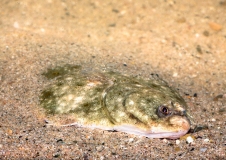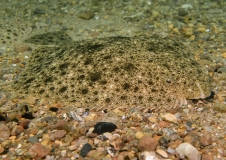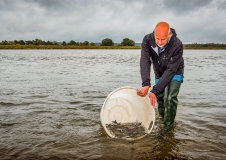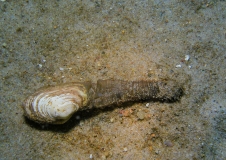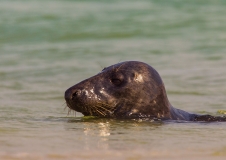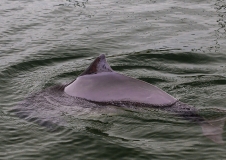The Pomeranian Bay Protected Area with Odra Bank – Area III
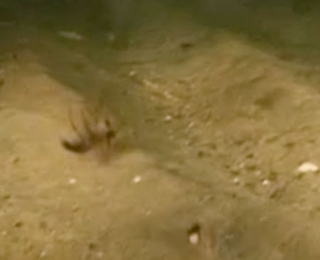
Facts Pomeranian Bay with Odra Bank (HD site) – Area III of the complex area
|
Fact sheet |
HD site |
|
|
Habitat types |
Sandbanks |
approx. 480 km² |
|
Species/Numbers |
Harbour porpoise (Phocoena phocoena) |
251-500 |
|
Twait shad (Alosa fallax) |
Feeding and wintering habitat |
|
|
Baltic sturgeon (Acipenser oxyrinchus) |
Feeding habitat |
Important characteristics of Area III
Species-rich benthic communities find ideal living conditions, as well as numerous flatfish species that grow up on the Oderbank. Marine mammals such as the harbour porpoise of the central Baltic Sea and grey seals can also be found here.
As the deep bottom water of the Baltic Sea cannot reach Odra Bank, no episodic oxygen deficiencies, anoxic conditions and water contaminated with hydrogen sulphide are known at Odra Bank nor are they to be expected here. Only a few benthic invertebrate species occur here, which is characteristic for this part of the Baltic Sea. However, thanks to the good oxygen and food supply, the occurring species can, to some extent, develop very high abundances and biomasses. This means that the benthic fauna is relatively species-poor, but very rich in individuals, and in particular sand gapers, tellins and cockles, as well as polychaetes and various species of crustaceans (Crustacea). As bottom trawling has been prohibited on a large section of Odra Bank for many years, the characteristic species mainly exhibit natural distribution patterns and population dynamics. The area has an outstanding importance as a durably available feeding area for many species, e.g. for various fish species.
Area III is of particular importance as a spawning and rearing area for turbot, plaice and flounder. Many flatfish species find abundant food here. Inexperienced young fish can also bury themselves quickly in the fine sands using their wave-like fin flap. Some species perfect their camouflage by adapting their pigmentation to the colour and structure of the ground.
Odra Bank is also especially important as a marine feeding and wintering habitat for whitefish (Coregonus lavaretus) and twait shad (Alosa fallax). Besides, Odra Bank is also regarded as an important potential marine distribution and feeding area for the sturgeon (Acipenser oxyrinchus), which was reintroduced into the Odra and its tributaries. After successful reintroduction, the Pomeranian Bay bordering on the Odra has again become an important marine subhabitat for this species, which used to be extinct here. Based on historical sources, Odra Bank is classified as an important potential marine feeding area for sturgeons.
Sturgeons and twait shads are among the anadromous migratory fish species that need special protection as species from Annex II of the Habitats Directive. Anadromous fish only migrate upriver for spawning; the adults live in the sea.
As a marine mammal species, harbour porpoises (Phocoena phocoena) have been recorded at Odra Bank, and even with seasonal concentrations ("hot spots") in winter. These are individuals from the eastern harbour porpoise population of the central Baltic Sea that is currently estimated at only around 500 individuals and regarded as very severely endangered. Especially in cold winters, the ice-free zones of the Pomeranian Bay are vital for these animals when they migrate from ice-covered regions of the Baltic Sea to the south. The degree of conservation of these endangered small whales is seen as highly deficient for the Pomeranian Bay.
As grey seal populations increase in the German Baltic Sea, especially in the waters around Rügen and Greifswalder Oie, Pomeranian Bay is increasingly becoming an important feeding and migration habitat for this seal species.
Spawning and rearing area for flatfish
Area III is of particular importance as a spawning and rearing area for turbot, plaice and flounder. Many flatfish species find abundant food here. Inexperienced young fish can also bury themselves quickly in the fine sands using their wave-like fin flap. Some species perfect their camouflage by adapting their pigmentation to the colour and structure of the ground.
Odra Bank is also especially important as a marine feeding and wintering habitat for whitefish (Coregonus lavaretus) and twait shad (Alosa fallax). Besides, Odra Bank is also regarded as an important potential marine distribution and feeding area for the sturgeon (Acipenser oxyrinchus), which was reintroduced into the Odra and its tributaries. After successful reintroduction, the Pomeranian Bay bordering on the Odra has again become an important marine subhabitat for this species, which used to be extinct here. Based on historical sources, Odra Bank is classified as an important potential marine feeding area for sturgeons.
Sturgeons and twait shads are among the anadromous migratory fish species that need special protection as species from Annex II of the Habitats Directive. Anadromous fish only migrate upriver for spawning; the adults live in the sea.
